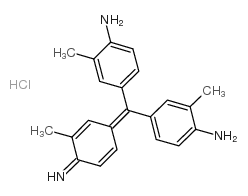3248-91-7
| 中文名 | 碱性紫 2 |
|---|---|
| 英文名 | new fuchsin |
| 中文别名 |
C.I.新品红
新品红 4-[(4-氨基-3-甲基苯基)(4-亚氨基-3-甲基-2,5-环己二烯-1-亚基)甲基]-2-甲基苯胺盐酸盐 碱性紫2 三甲基品红 |
| 英文别名 |
new
Basic Violet 2 isorubine Isorubin FUCHSIN EINECS 221-831-7 FUCHSIN,NEW New Fuchsin fuchsinnb MFCD00012567 FUCHSIN N MAGENTA III |
| 沸点 | 578.1ºC at 760 mmHg |
|---|---|
| 分子式 | C22H24ClN3 |
| 分子量 | 365.89900 |
| 闪点 | 303.4ºC |
| 精确质量 | 365.16600 |
| PSA | 75.89000 |
| LogP | 6.86970 |
| 外观性状 | 深紫色固体 |
| 储存条件 | 本品应密封干燥保存。 |
| 稳定性 | 常温常压下稳定, 粉末。为碱性品红中的组成 成分之一。溶于乙醇和水。最大吸收波长 553nm 。有刺激性。 |
| 计算化学 | 1、 氢键供体数量:4 2、 氢键受体数量:3 3、 可旋转化学键数量:2 4、 拓扑分子极性表面积(TPSA):75.9 5、 重原子数量:26 6、 表面电荷:0 7、 复杂度:585 8、 同位素原子数量:0 9、 确定原子立构中心数量:0 10、 不确定原子立构中心数量:0 11、 确定化学键立构中心数量:0 12、 不确定化学键立构中心数量:0 13、 共价键单元数量:2 |
| 更多 | 1. 性状: 不溶于水 2. 密度(g/mL,25/4℃): 1.001 3. 相对蒸汽密度(g/mL,空气=1): 4. 熔点( ºC ): -44 5. 沸点( ºC, 常压):6. 沸点(ºC,5.2kPa): 95 7. 折射率: 1.427 8. 闪点( ºC ): 78 9. 比旋光度( º ):10. 自燃点或引燃温度(ºC): 11. 蒸气压(kPa,25ºC): 12. 饱和蒸气压(kPa,60ºC): 13. 燃烧热(KJ/mol): 14. 临界温度(ºC): 15. 临界压力(KPa): 16. 油水(辛醇/水)分配系数的对数值: 17. 爆炸上限(%,V/V): 18. 爆炸下限(%,V/V): 19. 溶解性: |
Synonym:Basic Violet 2; C.I. 42520; Magenta III; Aniline, 4-[(4-amino-3-methylphenyl)(4-imino- 3-methyl-2,5-cyclohexadien-1-ylide; Benzenamine Section 2 - COMPOSITION, INFORMATION ON INGREDIENTS
Risk Phrases: 36 Section 3 - HAZARDS IDENTIFICATION EMERGENCY OVERVIEW
Irritating to eyes. Potential Health Effects Eye: Causes eye irritation. May cause chemical conjunctivitis. Skin: Causes skin irritation. Ingestion: May cause gastrointestinal irritation with nausea, vomiting and diarrhea. Inhalation: Causes respiratory tract irritation. Can produce delayed pulmonary edema. Chronic: Effects may be delayed. Section 4 - FIRST AID MEASURES Eyes: Immediately flush eyes with plenty of water for at least 15 minutes, occasionally lifting the upper and lower eyelids. Get medical aid. Skin: Get medical aid. Flush skin with plenty of water for at least 15 minutes while removing contaminated clothing and shoes. Wash clothing before reuse. Ingestion: Never give anything by mouth to an unconscious person. Get medical aid. Do NOT induce vomiting. If conscious and alert, rinse mouth and drink 2-4 cupfuls of milk or water. Inhalation: Remove from exposure and move to fresh air immediately. If not breathing, give artificial respiration. If breathing is difficult, give oxygen. Get medical aid. Notes to Physician: Treat symptomatically and supportively. Section 5 - FIRE FIGHTING MEASURES General Information: As in any fire, wear a self-contained breathing apparatus in pressure-demand, MSHA/NIOSH (approved or equivalent), and full protective gear. During a fire, irritating and highly toxic gases may be generated by thermal decomposition or combustion. Extinguishing Media: Use water spray, dry chemical, carbon dioxide, or appropriate foam. Section 6 - ACCIDENTAL RELEASE MEASURES General Information: Use proper personal protective equipment as indicated in Section 8. Spills/Leaks: Clean up spills immediately, observing precautions in the Protective Equipment section. Sweep up, then place into a suitable container for disposal. Avoid generating dusty conditions. Provide ventilation. Section 7 - HANDLING and STORAGE Handling: Wash thoroughly after handling. Remove contaminated clothing and wash before reuse. Avoid contact with eyes, skin, and clothing. Keep container tightly closed. Avoid ingestion and inhalation. Use with adequate ventilation. Wash clothing before reuse. Storage: Store in a tightly closed container. Store in a cool, dry, well-ventilated area away from incompatible substances. Section 8 - EXPOSURE CONTROLS, PERSONAL PROTECTION Engineering Controls: Facilities storing or utilizing this material should be equipped with an eyewash facility and a safety shower. Use adequate ventilation to keep airborne concentrations low. Exposure Limits CAS# 3248-91-7: Personal Protective Equipment Eyes: Wear appropriate protective eyeglasses or chemical safety goggles as described by OSHA's eye and face protection regulations in 29 CFR 1910.133 or European Standard EN166. Skin: Wear appropriate protective gloves to prevent skin exposure. Clothing: Wear appropriate protective clothing to prevent skin exposure. Respirators: A respiratory protection program that meets OSHA's 29 CFR 1910.134 and ANSI Z88.2 requirements or European Standard EN 149 must be followed whenever workplace conditions warrant respirator use. Section 9 - PHYSICAL AND CHEMICAL PROPERTIES Physical State: Powder Color: dark green Odor: None reported. pH: Not available. Vapor Pressure: Not available. Viscosity: Not available. Boiling Point: Not available. Freezing/Melting Point: Not available. Autoignition Temperature: Not applicable. Flash Point: Not applicable. Explosion Limits, lower: Not available. Explosion Limits, upper: Not available. Decomposition Temperature: Not available. Solubility in water: Not available. Specific Gravity/Density: Not available. Molecular Formula: C22H24ClN3 Molecular Weight: 365.89 Section 10 - STABILITY AND REACTIVITY Chemical Stability: Stable at room temperature in closed containers under normal storage and handling conditions. Conditions to Avoid: Incompatible materials, excess heat, strong oxidants. Incompatibilities with Other Materials: Strong oxidizing agents. Hazardous Decomposition Products: Hydrogen chloride, nitrogen oxides, carbon monoxide, carbon dioxide. Hazardous Polymerization: Has not been reported. Section 11 - TOXICOLOGICAL INFORMATION RTECS#: CAS# 3248-91-7: CX9825000 LD50/LC50: Not available. Carcinogenicity: New Fuchsin - Not listed by ACGIH, IARC, or NTP. Other: See actual entry in RTECS for complete information. Section 12 - ECOLOGICAL INFORMATION Section 13 - DISPOSAL CONSIDERATIONS Dispose of in a manner consistent with federal, state, and local regulations. Section 14 - TRANSPORT INFORMATION IATA Not regulated as a hazardous material. IMO Not regulated as a hazardous material. RID/ADR Not regulated as a hazardous material. Section 15 - REGULATORY INFORMATION European/International Regulations European Labeling in Accordance with EC Directives Hazard Symbols: XI Risk Phrases: R 36 Irritating to eyes. Safety Phrases: S 24/25 Avoid contact with skin and eyes. WGK (Water Danger/Protection) CAS# 3248-91-7: No information available. Canada CAS# 3248-91-7 is listed on Canada's DSL List. CAS# 3248-91-7 is not listed on Canada's Ingredient Disclosure List. US FEDERAL TSCA CAS# 3248-91-7 is listed on the TSCA inventory. SECTION 16 - ADDITIONAL INFORMATION N/A |
|
生态学数据: 通常对水是不危害的,若无政府许可,勿将材料排入周围环境 CHEMICAL IDENTIFICATION
|
| 危害码 (欧洲) | Xi |
|---|---|
| 风险声明 (欧洲) | R36 |
| 安全声明 (欧洲) | S26-S36/37-S24/25 |
| WGK德国 | 3 |
| RTECS号 | CX9825000 |
| 海关编码 | 32041300 |
| 海关编码 | 32041300 |
|---|


